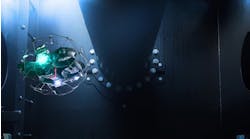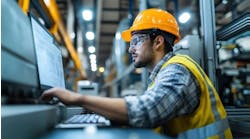Trondheim basin under review for ultra-deep water model tests
Correct modeling of platforms, waves and currents in artificial test basins is getting more critical, with offshore operations heading ever deeper. Physical limits of current basins are being reached, however, so research institutes such as Marintek in Trondheim are exploring new methods for testing deep water structures.
Marintek operates the Ocean Basin, the largest laboratory of its kind in the world. The basin measures 50 metres wide, 80 meters long and 10 meters deep. Model testing is usually done at scales from 1:50 up to 1:80. In practical terms, this means the basin can be used for testing models in water depths equivalent to 800 metres.
"The smallest model we ever tested in this basin had a scale of 1:135," says Kjell Larsen, naval architect and senior research engineer at Marintek's Department of Offshore Structures. "But these tests were performed using a new and more accurate position measuring system and also specially developed instrument gauges and amplifiers. In addition, the generated waves and currents had to be checked very carefully, and a thorough evaluation of result accuracy was performed afterwards."
The hydrodynamic verification procedures of complete systems to be installed in waters beyond 800-1,000 metres is not yet established. As a consequence, Marintek is looking for new strategies. "There are various problems when models become too small," Larsen explains.
"First, you have the viscous scale effects. Forces related to the viscosity of the water will, in general, not be the same as the viscous forces in full scale. Even the impact of water drops becomes a problem. Another problem is the size and weight of the instruments in relation to the models. And it is not easy either to generate reliable waves and currents at very small scales."
Marintel does not exclude the most obvious solution, simply making the Ocean Basin twice as deep. But with moorings and risers of production vessels at 2,000 metres, not only the depth but also the width of the basin becomes a problem.
Another option under investigation is the use of open waters for model testing, for example in a fjord. "We have been testing deep sea risers in the Trondheim fjord with a scale model of 1:30," says Larsen. "For this purpose, we had to develop specially designed accelerometers fitted inside the risers. The tests were a success and we consider this a possibility. A major challenge would be to control the wave, wind and current action."
The most serious option, however, is to exploit the simulation capacity of computers in combination with partial testing of models in the existing basin. With support from Norsk Hydro (68%) and the Norwegian Research Council (32%), Marintek is into the first phase of the VERIDEEP R & D project.
VERIDEEP is split into three phases and has a total budget of NKr6 million. Other would-be participants are welcome, says Larsen. The project is part of the Norwegian Research Council's UTBYGG study of environmentally friendly and cost-effective exploration of small petroleum reserves and deepwater technology.
VERIDEEP's objective is to improve technology for verification of deepwater structures, deepwater risers and station-keeping systems. This is with regard to seakeeping and motion characteristics of the surface vessel, loading and behavior of mooring lines and risers and total reliability of the system.
In the first project phase, testing techniques will be developed for small models. The second phase relates to combined verification techniques. Says Larsen: "We will establish procedures for optimum use of model tests in the basin with simplified mooring and riser systems in combination with advanced simulation tools." The third phase is aimed at studying the feasibility of model testing at sea.
Several tasks must be solved, he adds. "We will investigate how small models can be made. We will evaluate the uncertainties and establish procedures related to the use of scales of 1:100 up to 1:150. This may be type-dependent with different limitations for ships and semisubmersibles."
Marintek will also study which types of model simplifications can be allowed. "The aim is to extract as much information as possible from the simplified model test set-up and to put these data into advanced simulation tools such as the newly developed SIMRIF simulation program."
SIMRIF resulted from a merger between the simulation programs SIMO for vessel motions and RIFLEX for slender marine structures, the aim being to improve their accuracy and make them easier to use for deepwater applications. A team of three to six people will work on the VERIDEEP project over three years.
Copyright 1996 Offshore. All Rights Reserved.


